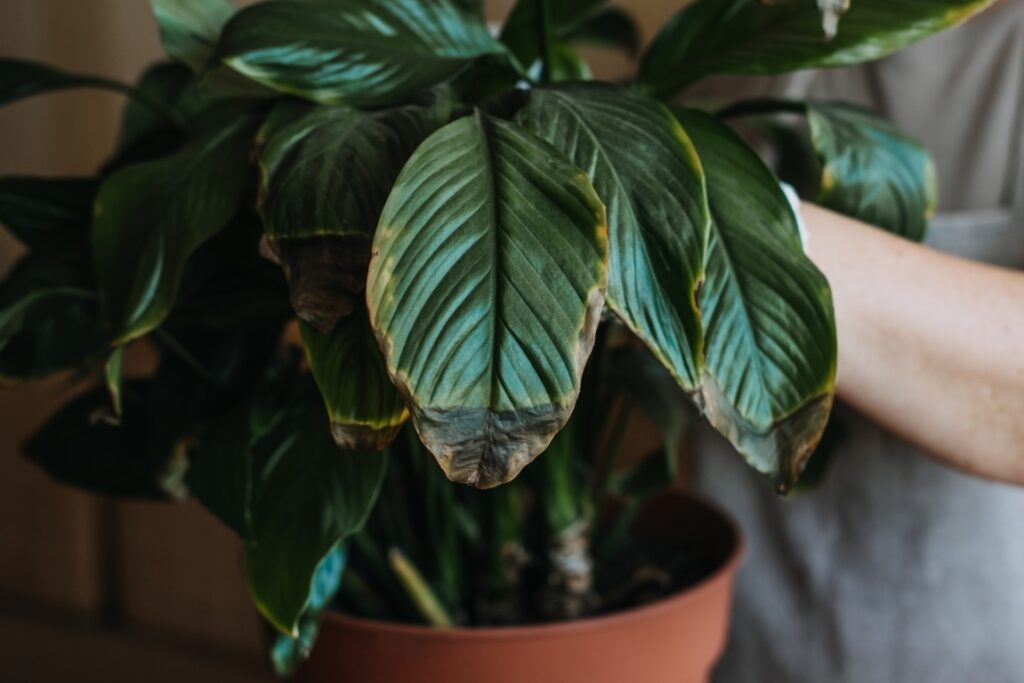Hey there, it’s your friendly explorer of all things fascinating, and today I’ve got a tale that’ll tickle your curiosity! So, me and my dear ol’ cousin came up with a quirky challenge that had us diving into the world of nature’s finest beauties – flowers! But hold on tight, ’cause there’s a twist – we decided to compile a list of flowers that start with Y. For a second, I halted! Do we actually have flowers that start with the letter Y?
Well, when you have a laptop and access to Google – everything’s possible. So, trusting my research abilities, I accepted the challenge and began researching. To my surprise, I came across a plethora of flowers beginning with the alphabet Y.
Do you want to know about them too? Keep on reading as I disclose the list below.
22 Flowers That Start With Y
1. Yarrow – Nature’s Resilient Healer

Yarrow (Achillea millefolium), is a hardy perennial that graces gardens with its delicate yet durable presence. With feathery foliage and clusters of small, flat-topped flowers, yarrow symbolizes healing, protection, and courage. Its versatility is reflected in its many colors, including shades of white, pink, and yellow.
Yarrow’s historical use as a medicinal herb spans centuries, cherished for its natural healing properties. It’s believed to aid in wound healing and was used by ancient warriors on battlefields. Beyond its healing reputation, yarrow’s clusters of flowers are a delight to pollinators, making it a valuable addition to pollinator gardens.
2. Yellow Iris – Elegance in Wetland Beauty

The Yellow Iris, characterized by its vivid yellow petals and blade-shaped leaves, is a perennial aquatic plant with hope, inspiration, and communication meanings. Scientifically known as Iris pseudacorus, this plant brings an air of refinement to wetland habitats and water gardens. Flourishing primarily in damp or aquatic surroundings, it injects a vibrant burst of color along the water’s edge.
Apart from its aesthetic appeal, Yellow Iris plays a role in ecosystem health by stabilizing soil along water bodies and providing habitat for various aquatic creatures. Its distinctive flowers stand tall on strong stems, creating a picturesque scene by the water’s edge.
3. Yellow Bells – Golden Chimes of Desert Lands

Yellow Bells, also called Tecoma stans, bring a splash of golden radiance to arid landscapes. Native to desert regions, these flowering shrubs symbolize warmth, adaptability, and happiness. Their trumpet-shaped, yellow blossoms create a stunning contrast against the dry desert backdrop.
Able to withstand the challenges of heat and drought, Yellow Bells thrive in well-drained soils and full sun. Their vibrant blooms attract hummingbirds and butterflies, contributing to the biodiversity of desert ecosystems. Whether planted as ornamental features in gardens or as hardy shrubs in native landscapes, Yellow Bells infuse the desert with a cheerful spirit.
4. Yucca – Majestic Presence in Arid Beauty
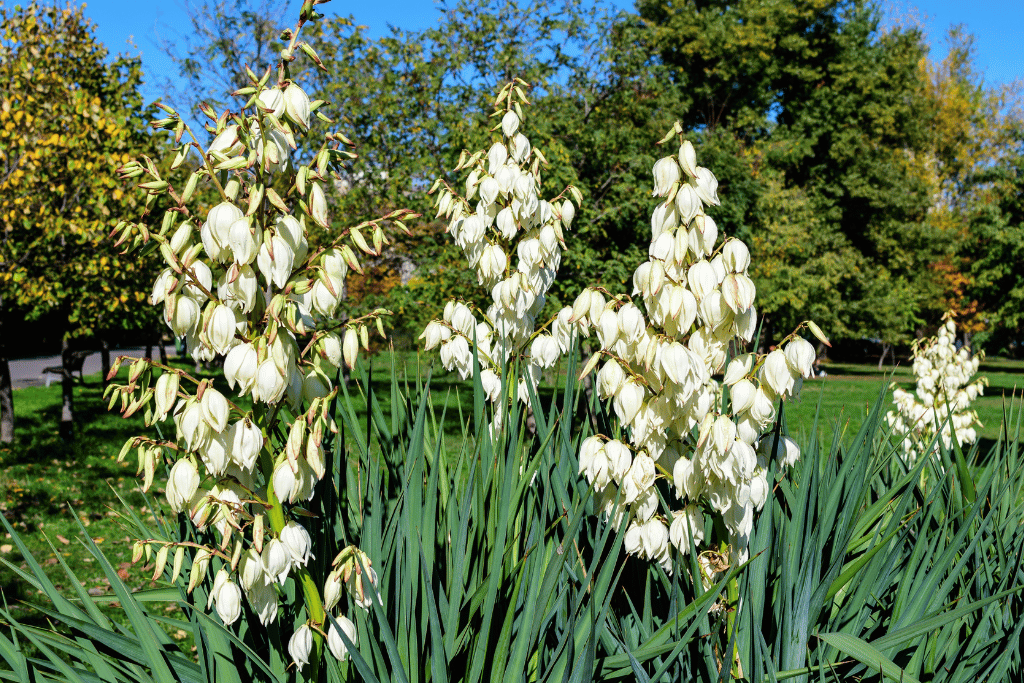
Yucca plants, belonging to the Asparagaceae family, showcase their grandeur in arid and desert landscapes. These hardy perennials symbolize strength, resilience, and purification. Their sword-like leaves and towering flower spikes create a striking silhouette against the barren desert backdrop.
The towering white or cream-colored spires of flowers exhibited by Yucca plants serve a dual purpose: enhancing the grace of challenging landscapes and providing a crucial sustenance source for yucca moths, nocturnal pollinators. Alongside their aesthetic value, the plant’s durable fibrous leaves hold a history of practical applications in crafting. By boldly thriving in gardens and untouched expanses, Yucca stands as a symbol of life’s persistence in arid regions.
5. Yellow Trumpet Vine – Nature’s Trumpet of Sunshine

As its name suggests, the Yellow Trumpet Vine’s large, golden flowers resemble musical trumpets, inviting pollinators to partake in their nectar. This fast-growing vine thrives in sunny locations and can be trained to climb arbors, trellises, and fences. Its cascading clusters of blossoms create a dramatic focal point, outdoor plants with a touch of natural radiance.
Yellow Trumpet Vine, botanically known as Campsis radicans or Tecoma radicans, brings a burst of sunshine to gardens with its vibrant trumpet-shaped flowers. Symbolizing friendship, positivity, and exuberance, this deciduous climbing vine is a beacon of color and charm.
6. Yellow Daisy – Sun-Kissed Charm in Every Petal
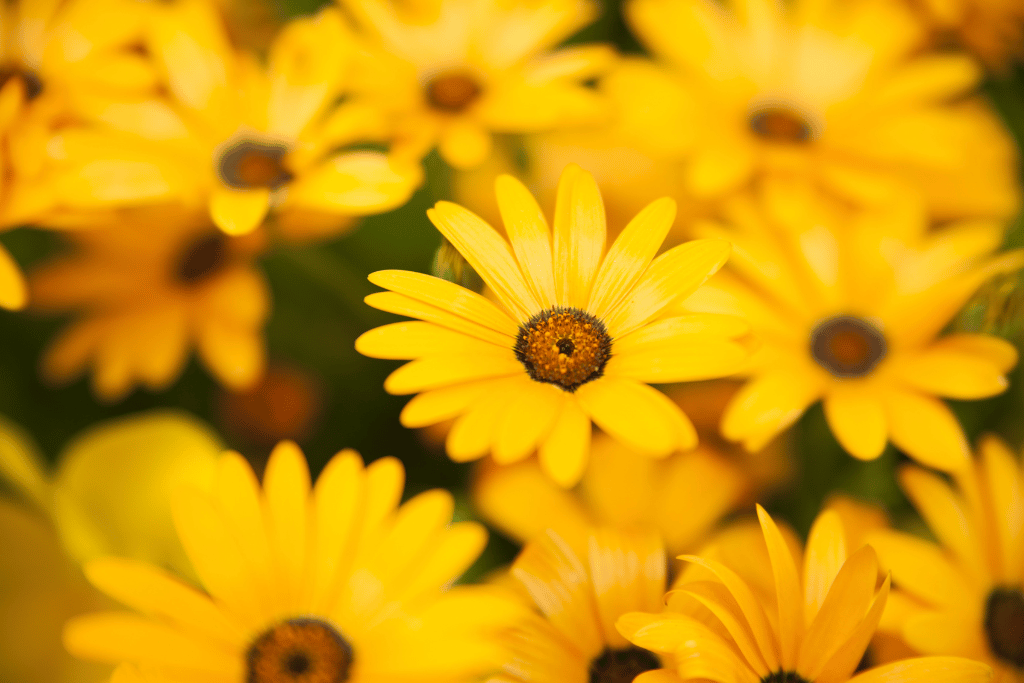
Native to South Africa, Yellow Daisies thrive in full sun and well-drained soil. Their daisy-like appearance and prolific flowering habit make them a popular choice for border plantings, containers, and rock gardens. These cheerful blooms not only please the human eye but also provide nectar for pollinators, supporting local ecosystems in their own sun-kissed way.
Yellow Daisy, (Euryops pectinatus), brings the sunny warmth of its blooms to gardens. Symbolizing optimism, happiness, and new beginnings, these daisies brighten up landscapes with their golden-yellow petals and vibrant green foliage.
7. Yellow Loosestrife – Wetland Splendor in Golden Hues
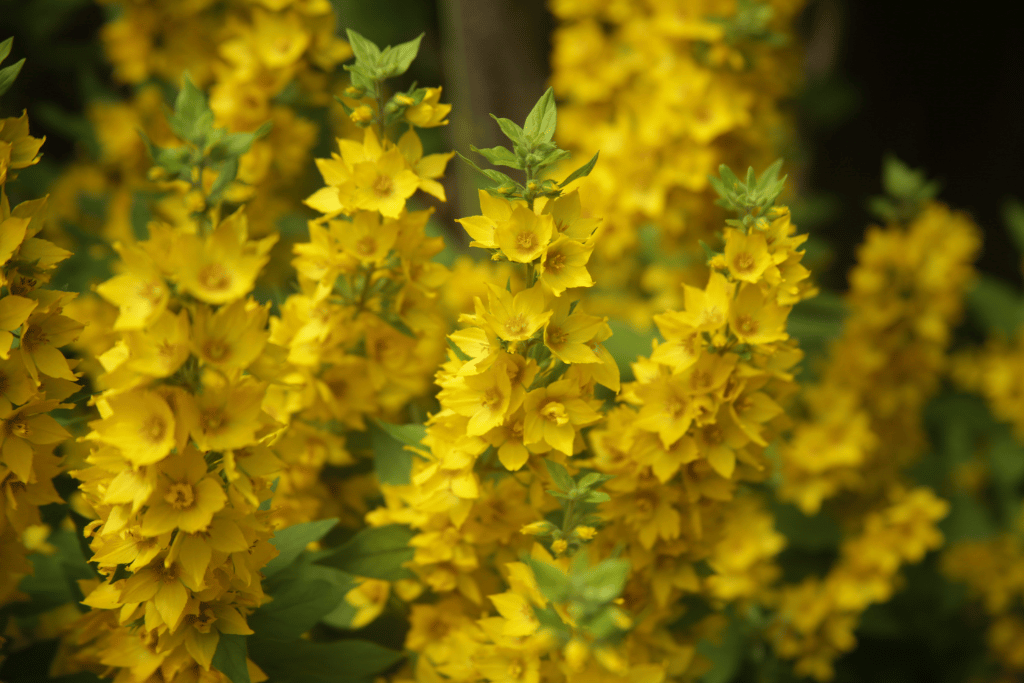
Yellow Loosestrife, scientifically known as Lysimachia punctata, introduces a touch of wetland magnificence to both gardens and natural landscapes. Signifying serenity, abundance, and luminosity, this enduring plant’s spires adorned with yellow blossoms forge a breathtaking juxtaposition against its verdant leaves.
Originating from Europe, the Yellow Loosestrife flourishes particularly in damp or waterlogged soils, rendering it a perfect selection for rain gardens and the peripheries of ponds. Its blossoms, brimming with nectar, exert a magnetic pull on bees and butterflies, thereby playing a role in bolstering local pollinator populations. Flourishing equally under sunlight and dappled shade, this refined plant casts its resplendent golden shades across an array of open-air scenes, augmenting the innate allure of water-centric environs.
8. Yellow Wax Bells – Subtle Elegance in Shady Retreats
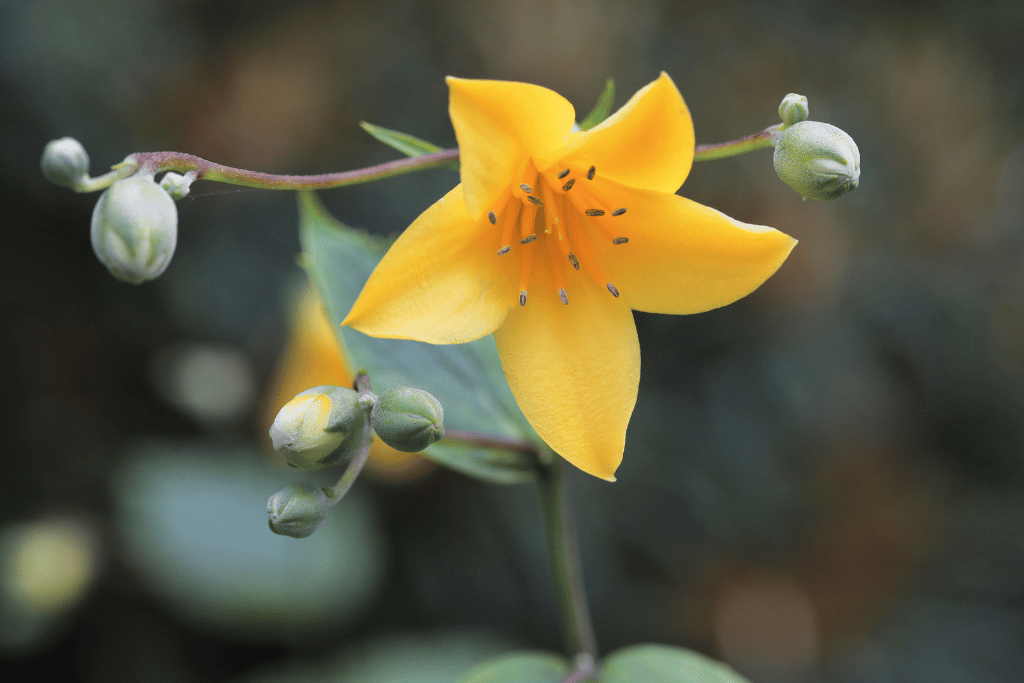
Yellow Wax Bells, originating from Japan and Korea, flourish in damp, well-drained soil and find their perfect home in woodland gardens. Botanically Known as, Kirengeshoma palmata, these plants add an unassuming elegance to shaded gardens. Symbolizing grace, serenity, and introspection, these perennial blossoms boast delicate, bell-shaped flowers that gently enhance dim corners.
Thriving in shadowed environments, these flora offer a chance to embrace nature’s more subtle instances. Their distinct waxy blooms, painted in pale yellow hues, establish a soothing ambiance, while their indented leaves contribute a textured dimension to the scenery.
9. Yellow Water Lily – Serenity in Aquatic Ponds
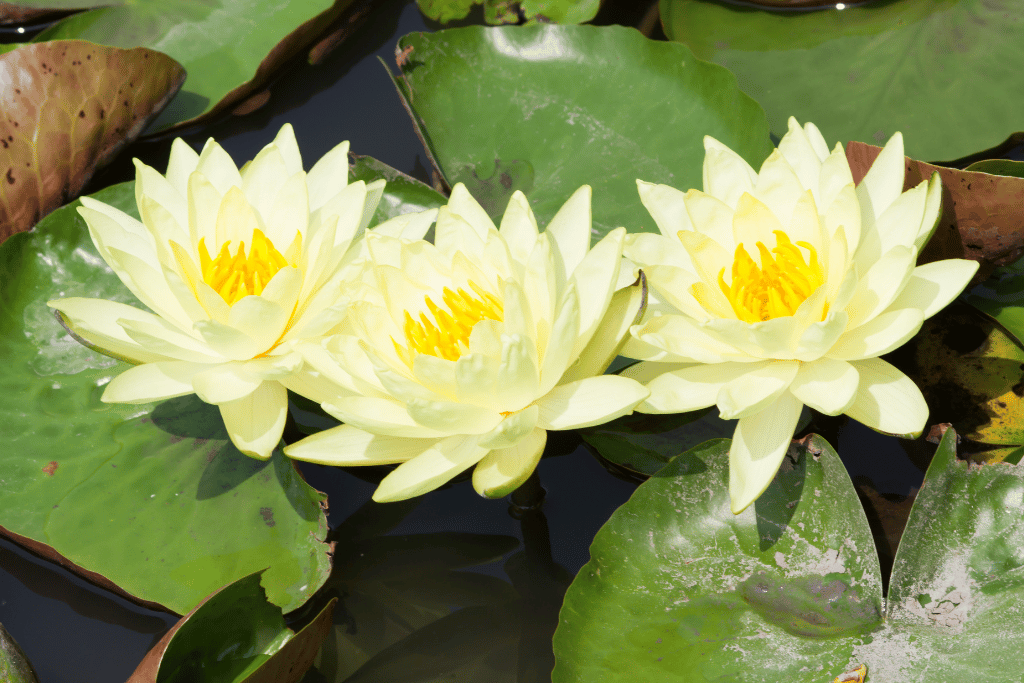
Yellow Water Lily, or Nuphar lutea, exudes serenity and natural elegance as it graces the surface of still waters. Symbolizing purity, enlightenment, and transformation, these aquatic perennials spread their vibrant yellow blooms across ponds, creating a haven for relaxation and reflection.
With their round, floating leaves and cheerful flowers, Yellow Water Lilies contribute to balanced aquatic ecosystems by providing shade and habitat for aquatic life. Their striking presence draws attention while imparting a sense of calm. Whether admired for their beauty or admired from afar as a symbol of serenity, these water lilies hold a special place in aquatic environments.
10. Yellow Jessamine – Southern Elegance in Fragrant Blooms
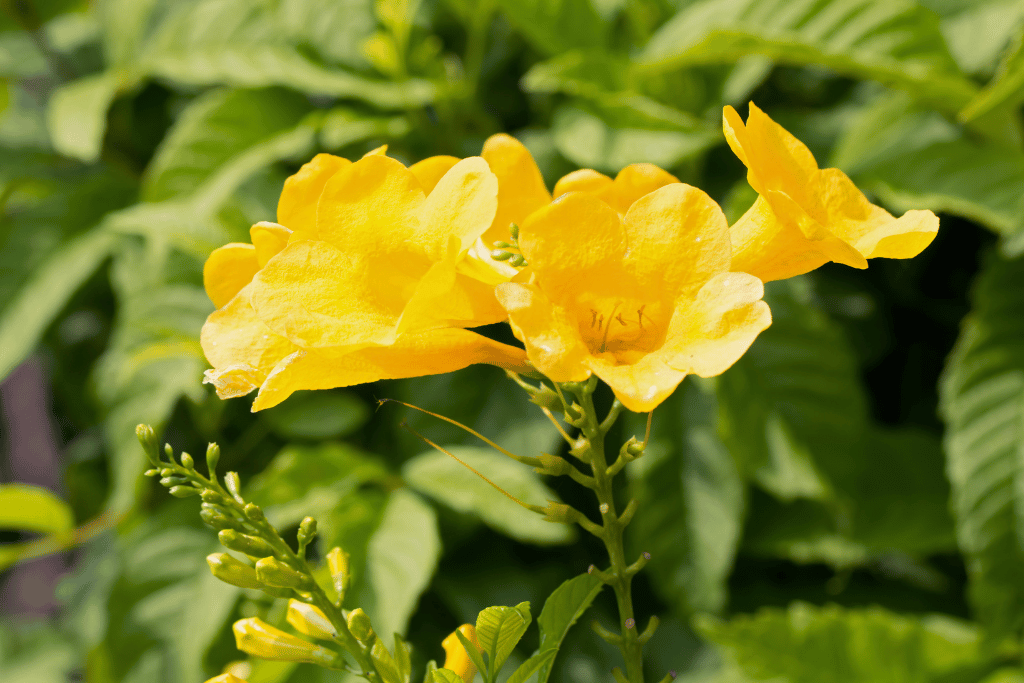
Native to the southeastern United States, Yellow Jessamine’s showy blooms are a harbinger of spring, attracting early-season pollinators. Its nectar-rich flowers are also a source of inspiration for Southern poets and artists. As it graces arbors, fences, and trellises, this vine infuses gardens with the charm of the South, offering a glimpse into the region’s natural beauty.
Scientifically, it is referred to as Gelsemium sempervirens, which lends its elegance and fragrance to Southern landscapes. Symbolizing grace, positivity, and friendship, this climbing vine’s trumpet-shaped flowers create a spectacle of gold against glossy green leaves.
11. Yulan Magnolia – Timeless Beauty in Early Spring

Yulan Magnolia, known for symbolizing purity, rebirth, and dignity, belongs to the group of deciduous magnolia species. It proudly displays large, fragrant flowers that gracefully unfurl before the emergence of its leaves. Scientifically referred to as Magnolia denudata, this flowering tree stands as a poetic embodiment of spring’s splendor.
Hailing from China, the Yulan Magnolia boasts not only its captivating beauty but also its profound cultural significance and utilization in traditional medicine. The immaculate white petals contrast harmoniously against the subdued branches, crafting a mesmerizing spectacle that encapsulates the very spirit of rejuvenation. Whether planted in cultivated gardens or observed in their untouched habitats, Yulan Magnolias eloquently embody the essence of spring’s awakening.
12. Yellow Archangel – Gleaming Ground Cover Charm
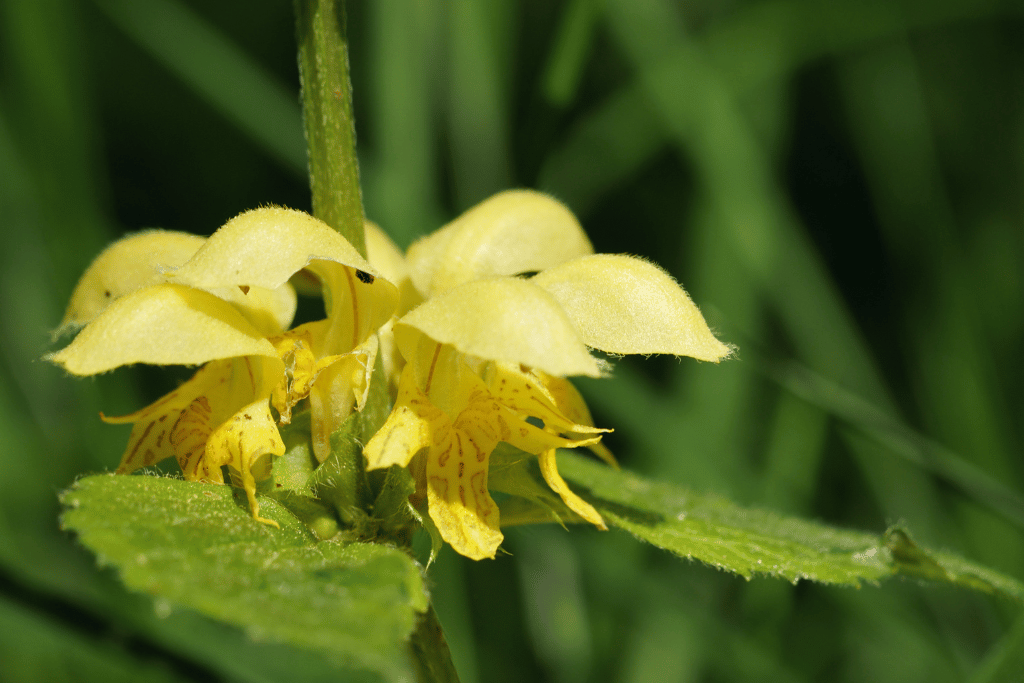
Yellow Archangel, or Lamiastrum galeobdolon, carpets shaded areas with its yellow-splashed foliage and subtle flowers. As an adaptable plant, it thrives in a range of light conditions, making it a versatile choice for shaded corners in need of a luminous touch.
Symbolizing illumination, transformation, and adaptability, this perennial ground cover brings a unique touch to woodland gardens. Native to Europe, Yellow Archangel’s silvery leaves feature variegated patterns that catch the light, creating an enchanting effect. Its hooded yellow flowers add a delicate touch to the ground-level scene.
13. Yellow Foxglove – Graceful Towering Beauty
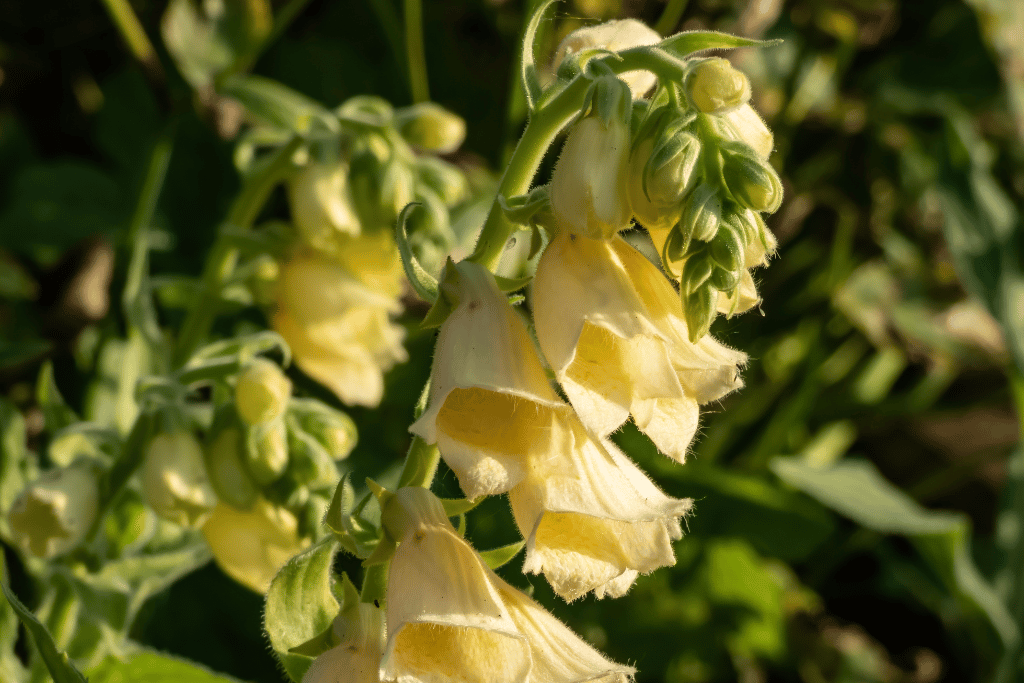
Yellow Foxglove, scientifically referred to as Digitalis grandiflora, graces gardens with its tall spires of yellow blossoms. Symbolizing charm, intuition, and protection, this biennial plant’s elegant flowers bring a touch of grandeur to borders and cottage-style landscapes.
Native to Europe, Yellow Foxglove’s bell-shaped flowers form along vertical spikes, creating a striking display that captures the eye. It’s an important plant for pollinators, providing nectar to bees and butterflies. As a biennial, it completes its life cycle over two years, with the first year focused on foliage growth and the second year dedicated to flowering. This captivating bloom adds a sense of enchantment to any garden.
14. Yellow Wood Sorrel – Whimsical Delight in Shamrock Leaves

Featuring clover-shaped leaves and delicate flowers, Yellow Wood Sorrel forms a delicate ground covering that flourishes in both sunlit and shaded locations. Its lemon-yellow blooms unfurl in the presence of sunlight, shutting during the night or overcast days, introducing an interactive aspect to its appeal. Whether used as a lively ground cover or a captivating supplement to potted gardens, Yellow Wood Sorrel injects a touch of whimsy into outdoor environments.
Yellow Wood Sorrel, or Oxalis stricta, adds a touch of whimsy with its delicate shamrock-like leaves and bright yellow flowers. Symbolizing joy, luck, and adaptability, this low-growing perennial brings a cheerful presence to gardens and natural spaces.
15. Yellow Evening Primrose – Twilight Beauty Unveiled

Yellow Evening Primrose, scientifically known as Oenothera biennis, enchants gardens with its fragrant, pale yellow blossoms that unfold in the evening. It Symbolizes mystery, beauty, and transformation, and this biennial plant offers a glimpse of nature’s hidden wonders.
With its delicate presence and twilight blooms, this primrose evokes a sense of magic and fascination. Native to North America, Yellow Evening Primrose’s flowers are a favorite of nighttime pollinators like moths. Its graceful petals open as the sun sets, releasing a sweet fragrance that adds to the allure of the garden after dark.
16. Yellow Stonecrop – Succulent Elegance in Gold
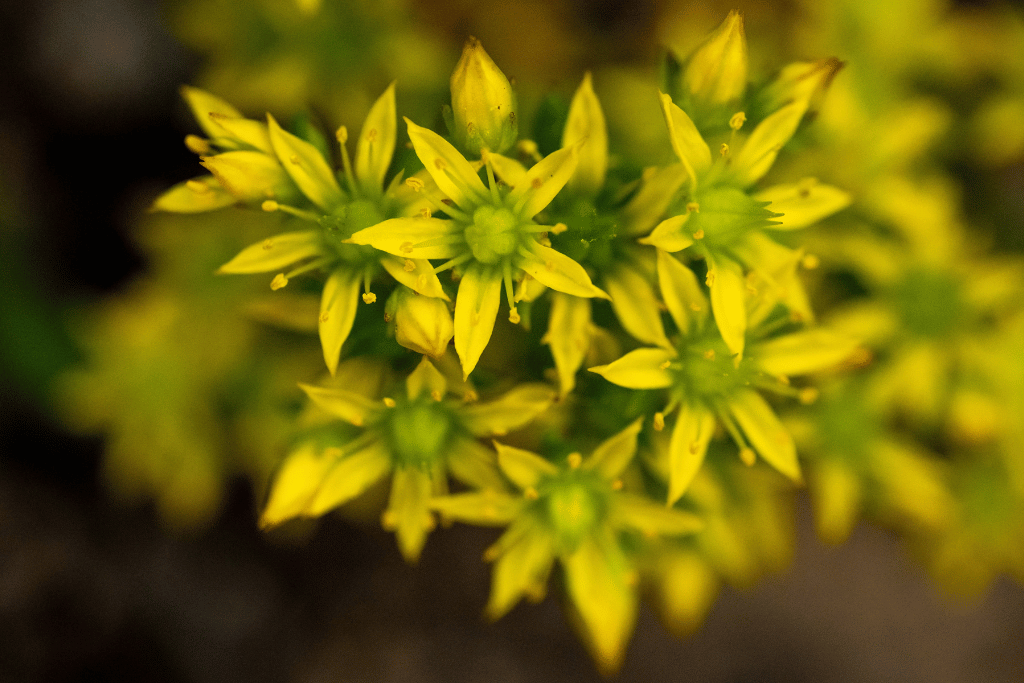
Yellow Stonecrop (Sedum acre) graces gardens with a touch of drought-tolerant refinement through its succulent foliage and vibrant yellow blossoms. Serving as a symbol of perseverance, flexibility, and profusion, this perennial marvel thrives effortlessly in arid or stony landscapes. Originating from Europe, the prostrate growth tendency of the Yellow Stonecrop makes it an impeccable selection for rock gardens, vegetated rooftops, and sun-kissed inclines.
It’s star-shaped yellow flowers create a remarkable interplay with its lush green, fleshy leaves. Beyond its aesthetic allure, this stonecrop holds intrinsic value for its capacity to endure rigorous conditions, all the while infusing parched terrains with a burst of vivid color.
17. Yellow Trillium – Forest Majesty in Triad Blooms

As an ephemeral spring flower, Yellow Trillium embodies the fleeting beauty of the forest’s hidden treasures. Native to North America, Yellow Trillium thrives in shaded woodlands, where its mottled leaves and delicate flowers add to the understory beauty. Its solitary, three-petaled blooms stand out against the lush green surroundings.
Yellow Trillium, or Trillium luteum, graces forest floors with its unique triad of leaves and golden-yellow flowers. Symbolizing spiritual growth, protection, and balance, this perennial plant’s presence evokes a sense of calm and unity with nature.
18. Yellow Monkey Flower – Whimsical Beauty in Sunny Shades
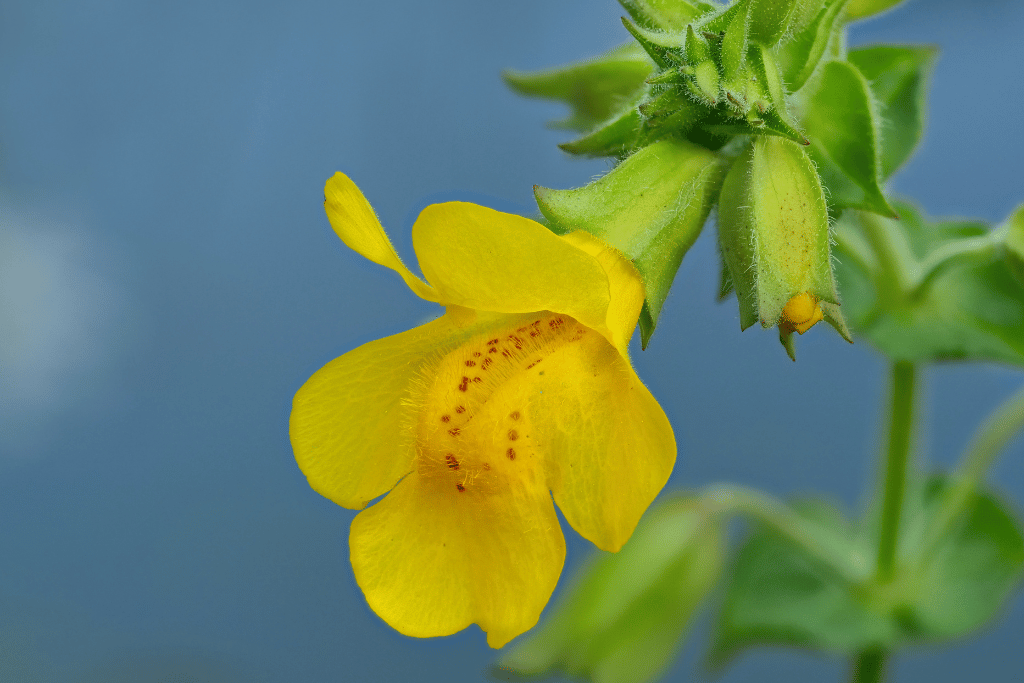
Native to North America, Yellow Monkey Flower thrives in damp soils and adds a pop of color to aquatic environments. Its snapdragon-like flowers, adorned with unique markings, attract pollinators like bees and butterflies. As a water-loving species, it contributes to the diversity of wetland ecosystems while offering a burst of sunny hues to landscapes.
In scientific language Yellow Monkey Flower is called as Mimulus guttatus, showcases its cheerful blooms in wetland habitats and water gardens. Symbolizing joy, playfulness, and adaptability, this perennial plant’s bright yellow flowers add a touch of whimsy to water’s edge.
19. Yellow Dahlia – Vibrant Splendor in Petal Diversity

Yellow Dahlia, scientifically known as Dahlia spp., is a symbol of inner strength, creativity, and positivity. These colorful blooms grace gardens with their diverse forms and shades of yellow, ranging from pale butter to deep gold.
With their vibrant presence and various shapes, Yellow Dahlias bring a burst of energy and radiance to landscapes. Originating from the highlands of Mexico, Dahlias are prized for their intricate, multi-layered petals and wide range of sizes. They are a favorite among gardeners and floral enthusiasts for their ability to create stunning bouquets and garden displays.
20. Yellow Freesia – Fragrant Elegance in Delicate Blooms
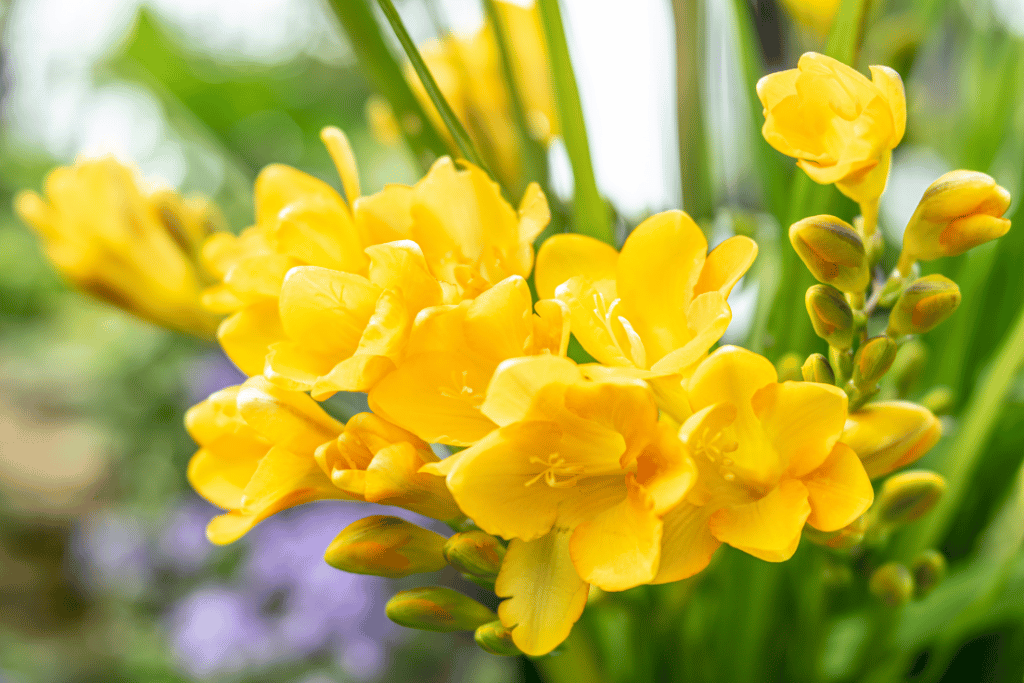
Originating from South Africa, Yellow Freesias are known for their elegant blossoms and delightful fragrance, embodying a sense of gracefulness. This springtime perennial carries a profound symbolism of friendship, innocence, and thoughtfulness, making it a beloved choice. Its dainty blooms, accompanied by a gentle aroma, create an atmosphere of subtle charm.
Whether adorning gardens or containers, these flowers introduce an element of sophistication. They can infuse outdoor spaces with their captivating presence, lending an air of refinement to any setting. Their slender stems and tubular flowers evoke a feeling of intimacy, endearing them to those with an eye for understated beauty.
21. Yellow Hyacinth – Aromatic Blossoms of Renewal

Yellow Hyacinth, botanically known as Hyacinthus orientalis, symbolizes rebirth, growth, and sincerity. These fragrant spring bulbs bring a burst of color and sweet aroma to gardens, marking the end of winter and the arrival of a new season.
These flowers serve as a poignant reminder of the cyclicality of existence and the splendor inherent in every fresh start. Indigenous to the eastern Mediterranean area, the Yellow Hyacinths boast densely packed blossoms that emerge from robust stems. With their lively petals and unique aroma, they hold a special place as beloved enhancements for gardens, edges, and pots.
22. Yellow Peony – Opulent Beauty in Blossom Majesty

Native to Asia, Peonies are celebrated for their show-stopping presence and lush, layered petals. Their large, fragrant flowers make them a sought-after choice for floral arrangements and bridal bouquets. As they unfurl their petals in late spring, Yellow Peonies create a spectacle of elegance and grace. Their timeless appeal and exquisite color add a touch of grandeur to outdoor spaces.
Yellow Peony, or Paeonia spp., embodies opulence, prosperity, and beauty in gardens and landscapes. These regal perennial flowers display their golden-yellow petals in a variety of forms, from single to double blooms.


